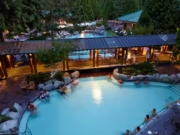Off-The-Grid: Coolest Small Towns in America
Escaping the Grid: Rediscovering Community and Nature
In an age dominated by screens, surveillance, and constant connectivity, the allure of an off-grid existence is growing stronger. It’s a yearning for simpler times, for genuine human connection, and for a deep-rooted harmony with nature.While the idea of completely disconnecting from modern conveniences might seem daunting, there are pockets of America where this dream is already a reality.
The Allure of Off-Grid Living
Living off the grid offers a unique blend of privacy, security, and self-reliance. Free from the prying eyes of cameras and the constant digital chatter, residents in these secluded communities enjoy a sense of peace and autonomy that’s hard to find elsewhere. It’s a world where relationships are built on trust and shared experiences rather than likes and followers.
Small-Town Serenity: America’s Hidden Gems
Several towns across the United States epitomize the off-grid lifestyle. Places like Bar Harbor, Maine; Telluride,Colorado; and Monterey, California, offer a captivating blend of natural beauty and a strong sense of community. These towns have managed to preserve their charm while offering modern amenities when needed.
Bar Harbor, with its rugged coastline and quaint fishing villages, invites visitors to slow down and reconnect with nature.Telluride, nestled in the San Juan Mountains, is a paradise for outdoor enthusiasts seeking adventure and solitude. Monterey, known for its stunning coastline and rich history, offers a more relaxed pace of life compared to its bustling neighbor, San Francisco.
The Human Experience: Reconnecting with Nature
Life in these towns is a testament to the human spirit’s resilience and adaptability. People here have cultivated a deep connection with the natural world, relying on the land for sustenance and inspiration. The pace of life is slower, allowing for moments of reflection and appreciation for the simple pleasures.
Stress levels are noticeably lower in these communities. The absence of constant notifications, traffic congestion, and the pressure to keep up with the Joneses creates a serene environment where people can truly be themselves. It’s a place where neighbors look out for one another, and children can roam freely without fear.
Unwind and Recharge
If you’re feeling overwhelmed by the demands of modern life, a visit to one of these towns can be a transformative experience. Leave behind the hustle and bustle and immerse yourself in nature’s beauty. Hike through pristine forests,breathe in the fresh air, and watch the stars at night.
Engage with the locals, learn about their way of life, and savor the genuine hospitality. Disconnect from technology and reconnect with yourself. These towns offer a rare opportunity to escape the noise and rediscover what truly matters.
Living off the grid is more than just a lifestyle choice; it’s a philosophy. It’s about prioritizing human connection,environmental stewardship, and a simpler, more fulfilling life. While it may not be for everyone, there’s no denying the allure of these secluded communities and the profound impact they can have on those who visit or choose to make them home.
Need an off-the-grid travel experience? Contact Dream2Career
























